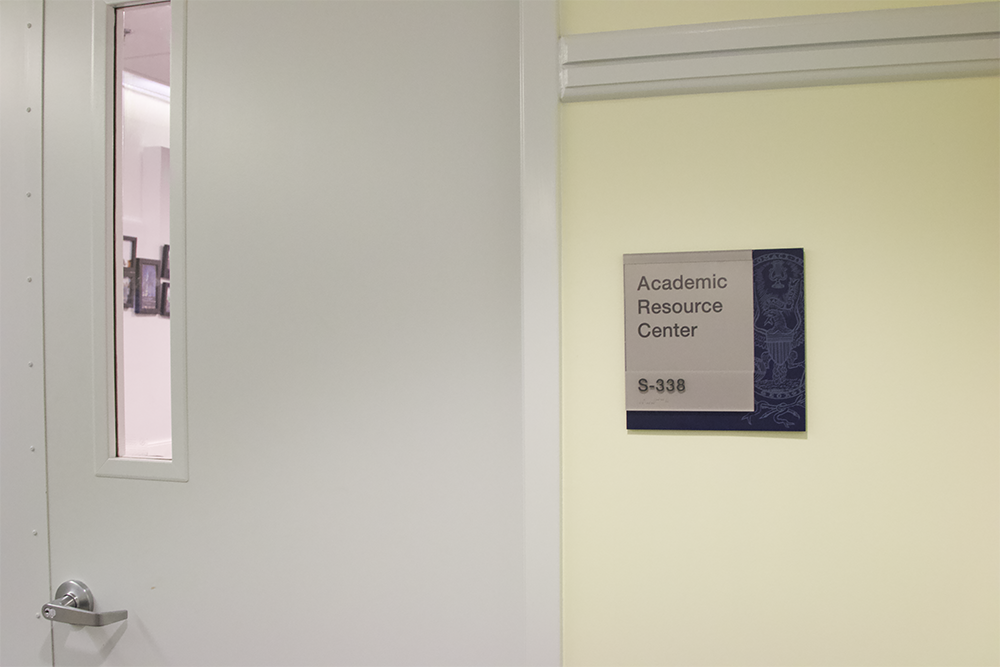When co-president of the Georgetown Disability Alliance Kenna Chick (SFS ’20) tried to propose creating mental health days at Georgetown University, her idea was met with resistance.
“It’s creating the idea that for someone with — anyone with — a disability, how much of our time is spent trying to prove that we belong here,” Chick said in an interview with The Hoya.
Students with invisible disabilities — disabilities that do not manifest themselves in physical appearance — must also prove their needs and face potential unwanted exposure for accommodations in academic settings that they depend on.
Invisible disabilities remain misunderstood by many students, professors and administrators in their efforts to make campuses more inclusive. To receive accommodations, students must go through an at times difficult process to receive proper documentation. As a result, recent activism has centered around moving past case-by-case accommodations in favor of making classrooms more accessible for these students.
Unobserved Inaccessibility
Often times, invisible disabilities can present students with difficulties in the classroom but imperfect accommodations do not give students the level of support that prioritizes their privacy.
Mental illness is considered an invisible disability, as well as hearing impairments, fatigue and cognitive impairments, according to the Invisible Disabilities Association. A study by the University of Massachusetts Amherst estimates that 10% of people in the United States have an invisible disability.
Invisible disabilities can indirectly affect how students process, retain and communicate information, according to the Disabilities, Opportunities, Internetworking, and Technology Center at the University of Washington. Students may struggle to focus, work with others, communicate with professors and take assessments, according to the center. Despite these common struggles, however, each individual experiences their disability in their own way.
Many people with invisible disabilities choose not to disclose them to avoid stigma, according to Georgetown professor Sylvia Wing Önder, who teaches anthropology, including courses about medical anthropology and biomedicine.

“One of the interesting things about an invisible disability is it can be hidden,” Önder said. “So, if you’re saying should all invisible disabilities just be exposed, and we should all just be open about it, as long as it’s stigmatized, it’s better for a lot of people who have invisible disabilities to keep them invisible.”
Although providing accommodations — means for students with disabilities to learn most effectively — is important, receiving them in classrooms may unintentionally out students with invisible disabilities, according to Anna Landre (SFS ’21), a wheelchair user and a founder of the Georgetown Disability Alliance.
“If you have an accommodation that you’re allowed to use a laptop because of a learning disability or some other sort of sensory disability, and you then take out your laptop and no one else has theirs out, you’re outing yourself,” Landre said. “Whereas if the professor just kind of said, ‘You know, I prefer you don’t use laptops, but if you need it, use it,’ then you wouldn’t be outing yourself as much.”
Accommodations need to account for students concerned about outing themselves as disabled, Önder said.
“We have to find a balance between giving people the support they need and requiring exposure in order to get benefits,” Önder said.
Some ways that classes are structured function as obstacles for people with invisible disabilities.
Pop quizzes generally do not accommodate for people who have ADHD and other invisible disabilities, according to University of California, Davis. Cold calling also can increase anxiety in students, according to the International Journal of STEM Education.
Georgetown students can obtain accommodations through The Academic Resource Center. The ARC works with other resource centers and offices to help students balance their curricular and extracurricular commitments and establish an inclusive campus environment, according to ARC Executive Director Joseph Fisher.
To receive accommodations, students must receive documents from a professional that corroborates their disability, which the ARC then examines to determine next steps.
Difficulties Diagnosing
The processes for receiving accommodations do not vary significantly between invisible and visible disabilities, according to Fisher.
“There are not significant differences in the processes for establishing a connection with the ARC based on disability status,” Fisher wrote in an email to the Hoya. “The staff of the ARC prioritizes an interactive process in which they will meet individually with students to allow them space to represent themselves in their own terms.”
After the ARC determines appropriate accommodations and measures, students receive a letter outlining what steps the professor can take to accommodate them in the classroom.
Difficulty in determining appropriate accommodations for students with psychological disabilities contribute to the lengthy process, according to a 2016 external review of the ARC.
“Often, these students require the closest consideration for appropriate accommodations and the greatest amount of time to collaborate with offices and colleagues throughout campus as well as external experts and parents,” the report reads.
This provision can create extra hurdles for students whose invisible disability requires diagnoses from mental health professionals that some students do not have access to, according to Chick.
“You need doctors’ papers and different notes to, sort of, document and support why you need a specific accommodation for your disability,” Chick said. “So, if you don’t have access to that, then you don’t get that accommodation in the first place.”
This process is more ambiguous for students who do not have a diagnosed disability. Counseling and Psychiatric Services and the ARC do not provide psychological testing for students who suspect they have a learning disability, but students can contact the ARC for further information.
Students seeking accommodations for ADHD will need to use other service providers, but CAPS will provide a screening test for ADHD to help students determine whether to seek a formal test, according to CAPS Director Philip Meilman. CAPS will also write letters in support of students seeking accommodation for anxiety, depression or other mental health conditions.
Although a mental health fund exists to assist students in finding mental health care off campus, only 10 to 20 students are estimated to receive the benefits. The student health insurance plan will also provide coverage, but only after meeting a $200 deductible that students must pay out of pocket before coverage kicks in.
For students on their own insurance plan, only about 55% of psychiatrists accepted private insurance, according to a 2014 study by the National Institutes of Health.
Redesigning the Classroom
Professors often have a minimal role in determining accommodations. Students usually give the professor their accommodations letter, which outlines the accommodations they have been granted, according to Önder.
Although professors are encouraged to engage in further conversations with students about accommodations, they often do not feel capable, Önder said.
“There is a lot of reluctance to engage in the conversation because it’s almost as if you know something, you have to do something about it, or you have to do something differently,” Önder said. “I wish more professors felt comfortable having those conversations because a lot of people don’t feel qualified, a lot of people feel insecure about whether they can successfully have a conversation.”
In an attempt to redesign the classroom, the ARC meets with faculty to create new approaches, according to Fisher.
“The ARC routinely works with faculty in both formal and informal settings to prioritize curricular access matters for all students,” Fisher wrote. “These efforts are collective and collaborative, and they are a central, ongoing component of our work.”
Although professors are generally open to making adjustments based on accommodations, the burden of responsibility is still placed on individual students to advocate for themselves, according to Libbie Rifkin, a professor in the disabilities studies program.
“There are ways to more broadly make classrooms more open that don’t put the burden on the individual student so much to both request the accommodation from ARC and then push for it, advocate for themselves in the classroom,” Rifkin said.
Examples of accommodations that can be provided include preferential seating, gaining access to presentations after class and being allowed to take frequent breaks during class, according to Chick and Landre.
Rifkin is trying to implement the idea of universal design, the idea that a classroom environment can be designed to be accessible and understood by the greatest amount of people possible. Universal design lightens the burden on students seeking accommodations for invisible disabilities, Rifkin said.
“Universal design is this idea that you can think about access needs in advance and put in as many openings to as many different ways of accessing an environment as you can in advance, rather than having to retrofit an environment for a particular individual,” Rifkin said.
Universal design for learning is being actively implemented at other institutions of higher education, including Boston College, The George Washington University, Harvard University, and Stanford University. Georgetown has also created online resources to raise awareness of universal design in partnership with the Center for New Designs in Leadership and Learning and The Teaching Commons.
Students in Önder’s “Disability and Culture” class take an anonymous learning styles survey at the beginning of the semester that asks questions regarding class participation and anxiety in class, among other topics.
Önder then uses these data to make adjustments to her teaching style and help students feel less isolated, she said.
“Someone who has a diagnosed anxiety problem might think they’re the only one in the classroom, but if I show on the screen that four people talk about anxiety as a regular part of their learning issues, then people know that there’s anxiety in the room,” Önder said. “So, we just try to surface that everyone learns differently and that people might not be as unique in their different learning styles as they might think.”







